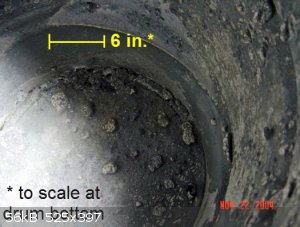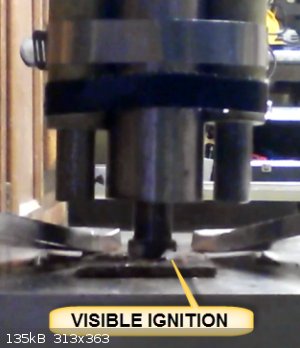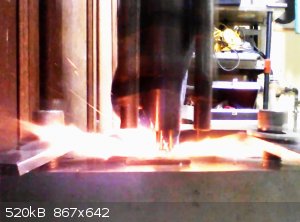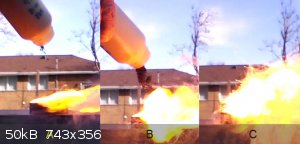| Pages:
1
2 |
froot
Hazard to Others
  
Posts: 347
Registered: 23-10-2003
Location: South Africa
Member Is Offline
Mood: refluxed
|
|
Dan I would imagine this risk assessment will have a discouraging feel about it.
There are too many unknowns to confidently say that the method described will proceed without any challenges.
No sane person would approve of this horrible idea.
I understand that this is outside of your scope but for the sake of discussion my suggestion would be to seal the sodium with wax first. A wax with a
melting point lower than that of sodium.
Say there is up to 2 inches of sodium in a barrel.
Add 2 inches of molten wax to capture any loose material on the sodium surface by spraying it in to wet all the loose material and help prevent it
from floating. . When that's cooled add another 2 inches of clean wax and let that cool.
Now you have a solid layer of around 6 inches. Cut the barrel into 2 pieces just above the wax layer and crush the top piece as flat as possible, you
should be able to get it thinner than 2 inches.
That would come to a total of less than 8 inches per barrel and no fires.
This would eliminate the possibility of barrels splitting at the sodium during crushing.
Questions are, could molten wax trigger any reactions?
How much potentially reactive material is stuck to the walls of the barrels?
We salute the improvement of the human genome by honoring those who remove themselves from it.
Of necessity, this honor is generally bestowed posthumously. - www.darwinawards.com |
|
|
unionised
International Hazard
    
Posts: 5102
Registered: 1-11-2003
Location: UK
Member Is Offline
Mood: No Mood
|
|
I wondered how long it would be before that vid surfaced.
I can't see this process getting to completion without a violent redox reaction.
Not every time- bust sooner or later.
It reduces the bulk- and I guess that makes it easier / cheaper to dig the hole.
But eventually the ground will sink + compact the barrels- well out of the range of any humans.
|
|
|
Dan Vizine
National Hazard
   
Posts: 628
Registered: 4-4-2014
Location: Tonawanda, New York
Member Is Offline
Mood: High Resistance
|
|
Quote: Originally posted by wg48  | 77,000 gallons of warm (radioactive) sodium is considered “none hazardous" ... That’s a definition I have not come across before.
A lot more than a few pounds per barrel then.
Its not that long ago they would have opened the barrels and dumped them at sea. I think we (EU and US) don't do that anymore. |
I say "was" because that was the original amount. The primary loop was 77,000 gallons which required 1400 drums. The sodium was melted and poured out.
These drums are what's left. The sodium was hydrolyzed to give enormous multi ton blocks of 70% NaOH and buried. I THINK the goal here may simply be
to turn 18 cargo containers into 5 since a well worked out method exists for total clean-up. It uses moist CO2 followed by water.
"All Your Children Are Poor Unfortunate Victims of Lies You Believe, a Plague Upon Your Ignorance that Keeps the Youth from the Truth They
Deserve"...F. Zappa
|
|
|
Dan Vizine
National Hazard
   
Posts: 628
Registered: 4-4-2014
Location: Tonawanda, New York
Member Is Offline
Mood: High Resistance
|
|
Quote: Originally posted by froot  | Dan I would imagine this risk assessment will have a discouraging feel about it.
There are too many unknowns to confidently say that the method described will proceed without any challenges.
No sane person would approve of this horrible idea.
I understand that this is outside of your scope but for the sake of discussion my suggestion would be to seal the sodium with wax first. A wax with a
melting point lower than that of sodium.
Say there is up to 2 inches of sodium in a barrel.
Add 2 inches of molten wax to capture any loose material on the sodium surface by spraying it in to wet all the loose material and help prevent it
from floating. . When that's cooled add another 2 inches of clean wax and let that cool.
Now you have a solid layer of around 6 inches. Cut the barrel into 2 pieces just above the wax layer and crush the top piece as flat as possible, you
should be able to get it thinner than 2 inches.
That would come to a total of less than 8 inches per barrel and no fires.
This would eliminate the possibility of barrels splitting at the sodium during crushing.
Questions are, could molten wax trigger any reactions?
How much potentially reactive material is stuck to the walls of the barrels?
|
Your opening was spot on. Or was a few days ago. Since then I came across a photo of a representative drum from this lot. The chunks are sodium
oxide/hydroxide/carbonate around a metallic core. There are pieces on the sides of the barrel. They look loosely adhering but you can't say for sure.
In my mind the real question is, when one of the lumps crushes, will that drive any hydroxide (and moisture of hydration) into fresh metal and cause a
fire? I see fire, not a raging thermite reaction, as the actual danger. Fire will release radioactive smoke. A thermite reaction would burn out very
quickly and not destroy the drum wall. There just isn't enough rust. But, it WOULD start the other available sodium burning.
Wax can pull away from walls when the crushing starts. Otherwise, no, it doesn't react with sodium. I favored mineral oil, but it's liquid and not
acceptable.
I have a series of good tests dreamed up and I've made a few test jigs. This weekend should be productive.

"All Your Children Are Poor Unfortunate Victims of Lies You Believe, a Plague Upon Your Ignorance that Keeps the Youth from the Truth They
Deserve"...F. Zappa
|
|
|
Dan Vizine
National Hazard
   
Posts: 628
Registered: 4-4-2014
Location: Tonawanda, New York
Member Is Offline
Mood: High Resistance
|
|
Burial was my uninformed guess way back when. Now, I am pretty sure that anything with elemental sodium in it just isn't able to be buried as
radioactive non-hazardous waste. This can only be about space-saving. They just want to avoid fire while crushing. Ultimate disposal will be at a
future date.
"All Your Children Are Poor Unfortunate Victims of Lies You Believe, a Plague Upon Your Ignorance that Keeps the Youth from the Truth They
Deserve"...F. Zappa
|
|
|
j_sum1
Administrator
       
Posts: 6218
Registered: 4-10-2014
Location: Unmoved
Member Is Offline
Mood: Organised
|
|
Ok. Here's an idea.
The sodium remaining is obviously in excess to the rust and the water. That which is there could potentially cause ignition but after that the
limiting reagent is atmospheric oxygen.
If the crushing could be done in a closed cylinder then air will be expelled and even if a reaction occurs it will quickly die out.
Say, a cylinder that the drums fit in reasonably snugly and a ram that is near to sealed against the wall of the cylinder. Add some temperature
measurement to the set-up so that you have information on when/if a reaction occurs. Crush slowly allowing air to escape. Monitor the temperature.
Remove ram and empty the cylinder when cool. You should be able to get a nice puck without an uncontrolled fire.
|
|
|
Dan Vizine
National Hazard
   
Posts: 628
Registered: 4-4-2014
Location: Tonawanda, New York
Member Is Offline
Mood: High Resistance
|
|
Quote: Originally posted by unionised  | I wondered how long it would be before that vid surfaced.
I can't see this process getting to completion without a violent redox reaction.
Not every time- bust sooner or later.
It reduces the bulk- and I guess that makes it easier / cheaper to dig the hole.
But eventually the ground will sink + compact the barrels- well out of the range of any humans.
|
As many things in life are, this is the provenance of statutes and rules, not common sense.
From my tests so far, unless the sodium is molten, no amount of crushing, compacting in a hydraulic press, or impact (up to and including a hand
sledge hammer swung with all my strength) will ignite the redox reaction. In my present view, prevent the sodium from burning or melting and we'll get
no thermite type reaction. Many more tests to follow, though.
"All Your Children Are Poor Unfortunate Victims of Lies You Believe, a Plague Upon Your Ignorance that Keeps the Youth from the Truth They
Deserve"...F. Zappa
|
|
|
Dan Vizine
National Hazard
   
Posts: 628
Registered: 4-4-2014
Location: Tonawanda, New York
Member Is Offline
Mood: High Resistance
|
|
Quote: Originally posted by j_sum1  | Ok. Here's an idea.
The sodium remaining is obviously in excess to the rust and the water. That which is there could potentially cause ignition but after that the
limiting reagent is atmospheric oxygen.
If the crushing could be done in a closed cylinder then air will be expelled and even if a reaction occurs it will quickly die out.
Say, a cylinder that the drums fit in reasonably snugly and a ram that is near to sealed against the wall of the cylinder. Add some temperature
measurement to the set-up so that you have information on when/if a reaction occurs. Crush slowly allowing air to escape. Monitor the temperature.
Remove ram and empty the cylinder when cool. You should be able to get a nice puck without an uncontrolled fire. |
We're starting to converge on thinking. Remember, though, thermite doesn't need oxygen. That is not a big deal (probably) because I think that unless
the sodium gets to the mp, crushing won't initiate the reaction. I doubt if crushing gets the metal anywhere near hot enough to melt the sodium. In
fact, I'd be willing to bet that crushing leads to no more than a handful of degrees of temp rise. The planned full scale test will confirm or deny
this.
Has anybody here used a drum crusher before? Ever felt a just-compacted drum?
"All Your Children Are Poor Unfortunate Victims of Lies You Believe, a Plague Upon Your Ignorance that Keeps the Youth from the Truth They
Deserve"...F. Zappa
|
|
|
wg48
National Hazard
   
Posts: 821
Registered: 21-11-2015
Member Is Offline
Mood: No Mood
|
|
Dan: I have not seen a drum compacted but I would expect there to be hot spots perhaps as the surfaces of the metal slides over each other. The
problem is how many drums do you have to compact to be confident there will not be hot spot or spark that can ignite the thermite or sodium and what
if there is sodium peroxide in the drum.
Ideally you need a set up such that any fire, leakage, minor explosion does not endanger personnel, damage the equipment or spread to the other drums.
[Edited on 23-2-2017 by wg48]
|
|
|
j_sum1
Administrator
       
Posts: 6218
Registered: 4-10-2014
Location: Unmoved
Member Is Offline
Mood: Organised
|
|
My point is that both iron oxide and atmospheric oxygen will be limiting reactants in a snug cylinder. If a reaction does begin you can simply wait
for it to die off and cool down. You might get a temporary sodium fire but there is no need to panic. Sparks, thermite, localised hot-spots and
melting need not cause problems. That leaves reaction with water present which might be a bit less predictable -- potentially explosive and certainly
releasing gas and a bit of heat. Mitigating against that possibility is the main reason for crushing slowly I think. It means there is some time
for H2 to escape and heat to dissipate. And if there is a coulombic explosion the vessel is not tightly compacted at the time.
I reiterate, this is not the way I would do it, but the most feasible practice I see within the constraints given.
|
|
|
j_sum1
Administrator
       
Posts: 6218
Registered: 4-10-2014
Location: Unmoved
Member Is Offline
Mood: Organised
|
|
Any updates Dan?
|
|
|
Sulaiman
International Hazard
    
Posts: 3554
Registered: 8-2-2015
Location: 3rd rock from the sun
Member Is Offline
|
|
Sodium metal can be extruded by a small hand tool to form sodium wire,
when the barrels are crushed I would expect any remaining unreacted sodium to be squeezed out of the bulk material.
Possibly a problem, possibly a coarse separation method ?
CAUTION : Hobby Chemist, not Professional or even Amateur
|
|
|
Dan Vizine
National Hazard
   
Posts: 628
Registered: 4-4-2014
Location: Tonawanda, New York
Member Is Offline
Mood: High Resistance
|
|
Since I last reported, much has been clarified to me. All of the odd restrictions now make utter sense. The goal isn't just to save space, it's
permanent sequestration in a very stable form. Probably one of the best sequestration techniques of all. Wish I could say more, more but the last
sentence really has a strong indication contained in it.
I took some interesting pictures during the preparation of this report, one of the pictures below shows a 20 J impact on a Na on rust smear. Barely
did anything, but some ignition seen. 40 J was another story. Results similar to the ~25 J/sq. cm accepted value for aluminum on steel
Another question was answered. How much moisture can soil contain and still act as a slow, controlled sodium oxidant? At a certain level, it works
beautifully. The attached picture was taken during trials to determine the allowable moisture level to act as an asphyxiant. The picture shows that
10% sure isn't it.
  
"All Your Children Are Poor Unfortunate Victims of Lies You Believe, a Plague Upon Your Ignorance that Keeps the Youth from the Truth They
Deserve"...F. Zappa
|
|
|
Dan Vizine
National Hazard
   
Posts: 628
Registered: 4-4-2014
Location: Tonawanda, New York
Member Is Offline
Mood: High Resistance
|
|
Quote: Originally posted by Sulaiman  | Sodium metal can be extruded by a small hand tool to form sodium wire,
when the barrels are crushed I would expect any remaining unreacted sodium to be squeezed out of the bulk material.
Possibly a problem, possibly a coarse separation method ? |
A report from the mid-80's indicates that the sodium exists as irregular rocky-looking masses of average size 1 - 4 inches. No liquid is seen in a
random sampling of 6 drums. The lumps are a nugget of sodium, coated with a layer of solid sodium hydroxide monohydrate. This is coated with hard,
crusty carbonate hydrates. I can't really reveal the method that was devised, but I think we've adequately addressed this.
"All Your Children Are Poor Unfortunate Victims of Lies You Believe, a Plague Upon Your Ignorance that Keeps the Youth from the Truth They
Deserve"...F. Zappa
|
|
|
j_sum1
Administrator
       
Posts: 6218
Registered: 4-10-2014
Location: Unmoved
Member Is Offline
Mood: Organised
|
|
All very mysterious. I wish you were able to reveal more.
But you are sounding a lot more confident about the whole process, which is a good thing.
|
|
|
Dan Vizine
National Hazard
   
Posts: 628
Registered: 4-4-2014
Location: Tonawanda, New York
Member Is Offline
Mood: High Resistance
|
|
Hello Again,
* WORK OPPORTUNITY *
The results of the last Na work helped secure the desired government contract and that project is proceeding.
There is a new contract and this is an opportunity for someone here (hopefully) to become involved.
The subject is something called MOMS. This acronym stands for...well, I'm writing it now...
"The process called metal oxide mitigation of sodium, commonly referred to as MOMS, is really a specialized variation of the same type of
metallothermic reaction of which thermite is an example. However, because of the relative free energies of the products and reactants, MOMS is a
gentle, easily controlled method of reacting sodium to form highly stable products. While initially designed to react sodium with a silica-based
substrate, the chemistry applies to other group 1 metals, particularly potassium."
The silica-based substrate is soil. We have a precise breakdown of its makeup, not surprisingly it's two thirds silica with a helping of hematite. And
a bunch of other things.
We're going to be looking at the reactions that I have tentatively worked out:
10 M + Fe2O3 + 6 SiO2 --> 5 M2SiO3 + 2 Fe + Si (M = Na, K)
and
4 M + 3 SiO2 --> 2 M2SiO3 + Si (M = Na, K)
What my contact requested is:
In addition to this we are interested in undertaking some computer modeling to simulate the thermodynamics and reaction
chemistry (multiphase transition). We are seeking some expertise in use of software like Star-CCM+, ANSYS Fluent, COMSOL, or other similar programs.
Do you have access and capabilities in this area or could you make recommendation?
So, if you are such a person, please contact me. I can put you in touch with them and this could be a good opportunity. It seems as though this
company is going to be involved in this sort of project in an ongoing fashion. A well-received piece of work could lead to you getting other pieces.
This is a world-class company, and if you aren't the person they are looking for you won't be able to fake it. This is clearly a job for either a grad
student, professor or working or retired professional. Hopefully you are that person and you and I will end up working together.
Please note that they hope you have some sort of access to one of the software packages, in addition to simply knowing how to use it. They won't be
supplying any software. Compensation is very generous.
In this case we're going to be looking at ways of disposing of radioactive NaK and radioactive LiH via a modified MOMS.
See: Geomelt, but this will be in a container.
Dan
[Edited on 5/17/2017 by Dan Vizine]
"All Your Children Are Poor Unfortunate Victims of Lies You Believe, a Plague Upon Your Ignorance that Keeps the Youth from the Truth They
Deserve"...F. Zappa
|
|
|
MrHomeScientist
International Hazard
    
Posts: 1806
Registered: 24-10-2010
Location: Flerovium
Member Is Offline
Mood: No Mood
|
|
Surely they don't expect people to have personal copies of those software packages? I use COMSOL at work and that's a $20,000 piece of software.
|
|
|
Dan Vizine
National Hazard
   
Posts: 628
Registered: 4-4-2014
Location: Tonawanda, New York
Member Is Offline
Mood: High Resistance
|
|
No, I think that was implicit in the statement. He just said access it.
"All Your Children Are Poor Unfortunate Victims of Lies You Believe, a Plague Upon Your Ignorance that Keeps the Youth from the Truth They
Deserve"...F. Zappa
|
|
|
Dan Vizine
National Hazard
   
Posts: 628
Registered: 4-4-2014
Location: Tonawanda, New York
Member Is Offline
Mood: High Resistance
|
|
OK, Thanks guys. I see a quite a few people at least gave it a glance, and I appreciate it.
Dan
PS. The expiration date on this is indeterminate. The contract is still in the bidding phase, anyway. So, if someone eventually sees this and wants to
reply, please do. It's not necessarily too late until I post otherwise.
[Edited on 5/22/2017 by Dan Vizine]
"All Your Children Are Poor Unfortunate Victims of Lies You Believe, a Plague Upon Your Ignorance that Keeps the Youth from the Truth They
Deserve"...F. Zappa
|
|
|
Dan Vizine
National Hazard
   
Posts: 628
Registered: 4-4-2014
Location: Tonawanda, New York
Member Is Offline
Mood: High Resistance
|
|
Quote: Originally posted by MrHomeScientist  |
Surely they don't expect people to have personal copies of those software packages? I use COMSOL at work and that's a $20,000 piece of software.
|
Whew! I just obtained a copy of COMSOL 5.1. After installing for an hour, it works. I guess. It's hard to say, really . Even after an afternoon of
YouTube videos, it's difficult to even know where to begin. Well, that isn't my problem, thankfully.
[Edited on 5/23/2017 by Dan Vizine]
"All Your Children Are Poor Unfortunate Victims of Lies You Believe, a Plague Upon Your Ignorance that Keeps the Youth from the Truth They
Deserve"...F. Zappa
|
|
|
| Pages:
1
2 |